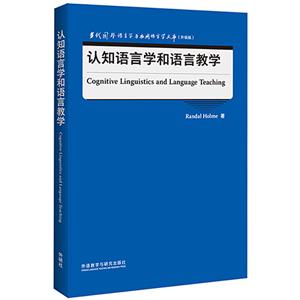-
>
西班牙语词根宝典
-
>
英语大书虫世界经典名译典藏书系:中国人的精神 (英汉对照)(精选权威版本)
-
>
许渊冲译唐诗三百首:汉文·英语
-
>
四级词汇词根+联想记忆法:乱序版
-
>
The secret garden
-
>
英国文学名篇选注
-
>
许渊冲译千家诗
认知语言学和语言教学(当代国外语言学与应用语言学文库)(升级版) 版权信息
- ISBN:9787521328707
- 条形码:9787521328707 ; 978-7-5213-2870-7
- 装帧:一般胶版纸
- 册数:暂无
- 重量:暂无
- 所属分类:>
认知语言学和语言教学(当代国外语言学与应用语言学文库)(升级版) 本书特色
适读人群 :学生,教师“当代国外语言学与应用语言学文库”(升级版)是主要面向高校英语专业高年级本科生、研究生及英语教师的一套大型、开放的系列丛书。本升级版或保留原有经典图书品种,或继之以经典图书的新版,或引进国外语言学与应用语言学领域的新锐力作以进一步拓展学科领域,希望它能继续对我国语言学教学与研究和外语教学与研究起到积极的推动作用。 《认知语言学和语言教学》是“当代国外语言学与应用语言学文库”(升级版)中的一本,本书将认知语言学与语言教学相结合,对语言教学的目的进行了重新定位:语言教学培养的不是在单一文化环境中生存的学习者,而是在各种文化群体之间能自如交流和沟通的学习者。此外,作者还有针对性地设计了适合课堂教学的练习和活动,非常实用。
认知语言学和语言教学(当代国外语言学与应用语言学文库)(升级版) 内容简介
进入21世纪后,认知语言学研究表现出的一个比较明显的趋势是与其他学科相结合,产生了新的研究视角。本书的优选亮点是作者并没有空泛地倡导用认知语言学理论指导二语课堂教学,而是有针对性地设计了不少适用于课堂教学的练习和活动,其中既有词汇学习方面的活动,也有语法学习方面的活动。本书是将认知语言学理论运用于语言教学实践的一个大胆且有益的尝试。
认知语言学和语言教学(当代国外语言学与应用语言学文库)(升级版) 目录
List of Activities xxiii
List of Figures and Tables xxv
1 Introduction 1
The linguistics applied approach: generative linguistics and second language learning 2
The applied linguistics of second language learning 4
Language as a social semiotic 5
The emergence of cognitive linguistics 6
Ending the LA-AL divide 10
The purpose of the book 12
Part I Embodied Experience
2 The Problem of Linguistic Meaning 17
Introduction 17
The problem of meaning 17
Language learning as category learning 21
Conclusions 27
3 Conceptualisation, Embodiment and the Origins of Meaning 29
Introduction 29
Proprioception: how the body remains aware of its own position in space 31
Not seeing but conceptualizing 32
Cognitive development and infant movement 33
Aplasic phantoms 34
Mirror neurons 35
The nature of language: image schemas and embodied cognition 36
Education and embodiment 39
Language teaching and embodiment: language as rhythm and movement 41
Language teaching and embodiment: mime, enactment and movement 44
Language teaching and embodiment: rethinking TPR 48
Conclusions 52
4 Gesture 54
Introduction 54
The importance of gesture in communication 54
Gesture in education 56
Gesture and teaching prepositions 58
Gesture and English articles 60
Conclusions 62
Part II Conceptualisation
5 Language, Culture and Linguistic Relativity 65
Introduction 65
The Sapir-Whorf hypothesis 67
Meaning and conceptualization 69
Linguistic relativity: how different is different? 75
Experimental evidence for linguistic relativity 77
To learn new meanings, do we have to conceptualise the world differently? 80
Second language errors and linguistic relativity 81
Errors that use first language forms and meanings within the second language 84
Errors that over-generalise some acquired formal or semantic feature of the second language 86
False friends 88
The problem of separating meaning from conceptualization 89
Can one change a conceptualisation? 90
Language, culture and conceptualisation in the classroom 92
Language, culture and learning 95
Different meanings for different languages 100
Conclusions 108
6 Conceptualisation and Construal 111
Introduction 111
Construal operations 112
Attention and salience 113
Attention, salience and enactive SLA 113
Metonymy: attention and salience 117
Scope of attention 120
Scalar adjustment 123
Dynamic attention 125
Judgment and comparison 129
Category formation 129
Category formation and language teaching 130
Metaphor 134
Metaphor and language teaching 134
Metaphor analysis 135
Metaphor and target language differentiation 136
The explanatory power of metaphor and analogy 136
Using metaphor to learn second language lexis and grammar 138
Figure-ground conceptual operations, force dynamics and action chains 142 rspectives and situatedness 147
Deixis 150
Constitution/gestalt 152
Geometry 155
Conclusions 157
Part III Meaning and Usage
7 Teaching Encyclopaedic Meaning 161
Introduction 161
Word networks: hyponymy and schematicity 163
Word networks: meronymy 165
Crossing category borders 167
Knowledge types and encyclopaedic meaning 168
Finding the frame 169
Phonological sense relations 171
Conclusions 174
8 Usage and Grammatical Meaning 177
Introduction 177
Constructions 178
Type and token 179
Usage 181
Language learning as construction learning 183
Recognising constructions 183
Teaching constructions 184
Teaching filled constructions: idioms 185
Teaching partially filled constructions: lexis, meaning and conceptualization 186
Teaching partially filled constructions: bound morphemes, inflections and lexis 187
Teaching partially filled constructions: bound morphemes 188
Teaching partially filled constructions: lexis and morphemes 192
Teaching partially filled constructions: lexis 197
Teaching unfilled constructions 201
Routines for more advanced students: lexis, meaning and conceptualization 205
Encountering constructions 205
Finding useful forms 206
Conclusions 212
Part IV Conclusions
9 Towards a Cognitive Linguistics Syllabus 217
Introduction 217
Product and process 217
Language teaching implications 218
Re-embedding linguistic form in the imagery and movement from which it emerged 219
Engage the learners in the explicit analysis of form and meaning 220
A forum for usage 226
Sequencing 227
Bibliography 231
Index 244
认知语言学和语言教学(当代国外语言学与应用语言学文库)(升级版) 作者简介
兰德尔·霍姆(Randal Holme):英国杜伦大学语言中心主任,主要研究兴趣为语言学、应用语言学以及语言教学中对创意写作的应用。
- >
山海经
山海经
¥17.7¥68.0 - >
朝闻道
朝闻道
¥8.8¥23.8 - >
莉莉和章鱼
莉莉和章鱼
¥13.4¥42.0 - >
企鹅口袋书系列·伟大的思想20:论自然选择(英汉双语)
企鹅口袋书系列·伟大的思想20:论自然选择(英汉双语)
¥6.3¥14.0 - >
伊索寓言-世界文学名著典藏-全译本
伊索寓言-世界文学名著典藏-全译本
¥9.3¥19.0 - >
诗经-先民的歌唱
诗经-先民的歌唱
¥13.5¥39.8 - >
姑妈的宝刀
姑妈的宝刀
¥9.0¥30.0 - >
伯纳黛特,你要去哪(2021新版)
伯纳黛特,你要去哪(2021新版)
¥15.9¥49.8
-
中国对外传播话语模式研究
¥26.4¥33.9 -
英语世界的《金瓶梅》翻译与研究:::
¥42.8¥58 -
4.23文创礼盒A款--“作家言我精神状态”
¥42.3¥206 -
4.23文创礼盒B款--“作家言我精神状态”
¥42.3¥206 -
一句顶一万句 (印签版)
¥40.4¥68 -
百年书评史散论
¥14.9¥38



















